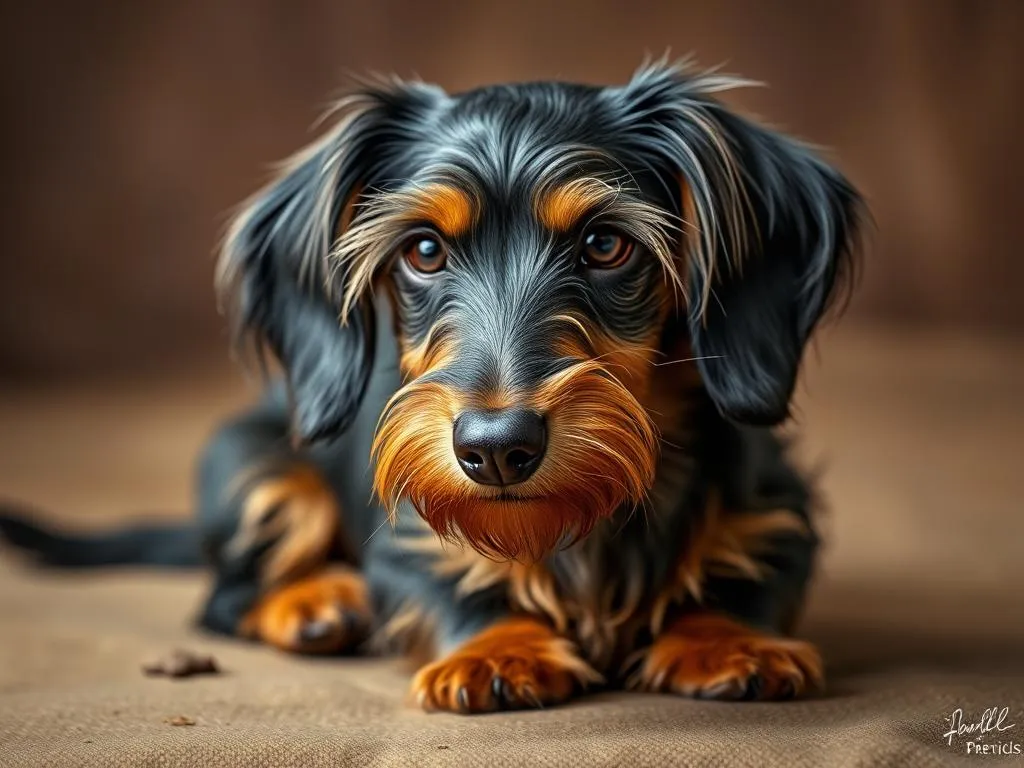
Introduction
Dog breeds are distinct categories of dogs that have been selectively bred for various traits, including size, temperament, and purpose. The significance of understanding different breeds lies in the fact that each breed has its own unique characteristics and needs, which can greatly influence the compatibility between a dog and its owner.
Choosing the right breed is crucial for a harmonious relationship. Factors to consider include lifestyle, living situation, activity level, and family dynamics. Among the myriad of dog breeds available, the wirehaired dachshund stands out for its unique traits and charming personality.
History of the Wirehaired Dachshund
Origins
The wirehaired dachshund has a fascinating history that traces back to Germany in the 19th century. This breed was developed from the standard dachshund, which was primarily bred for hunting purposes, particularly to track and hunt burrowing animals like badgers. The introduction of the wirehaired coat was a deliberate effort to enhance the dog’s ability to work in rough terrain, providing protection against thorns and brambles.
Purpose of the Breed
Initially, wirehaired dachshunds were employed as hunting dogs, recognized for their keen sense of smell and determination. They were often used in pairs, with one dog tracking and the other flushing out the prey. Their small size made them ideal for burrowing into dens and hunting in tunnels, which was crucial for hunters of that era.
Evolution Over Time
As hunting practices evolved, so did the breeding practices for the wirehaired dachshund. While they remain competent hunters, the breed has also gained popularity as a companion animal. This shift in purpose has led to changes in temperament and physical traits, catering more to family life than solely to hunting.
Characteristics of Wirehaired Dachshunds
Physical Traits
The wirehaired dachshund is a small breed, typically weighing between 16 to 32 pounds, depending on whether they are standard or miniature. They have a long, low-slung body and short legs, which are characteristic of all dachshunds. The most distinguishing feature, however, is their dense, wiry coat, which can come in various colors, including red, black and tan, and chocolate. This coat requires special attention to maintain its texture and prevent matting.
Temperament
Wirehaired dachshunds are known for their lively and affectionate nature. They are often described as curious, intelligent, and sometimes stubborn, which can make training a challenge. They tend to form strong bonds with their families and can be protective, making them excellent watchdogs. Their playful demeanor makes them great companions for children, but early socialization is essential to ensure they develop friendly behaviors towards other pets and people.
Health Considerations
Like all breeds, wirehaired dachshunds are susceptible to certain health issues. Common concerns include intervertebral disc disease (IVDD) due to their elongated spine, obesity, and dental problems. The average lifespan of a wirehaired dachshund ranges from 12 to 16 years, and regular veterinary check-ups are essential for maintaining their health.
Care and Maintenance
Grooming Needs
Grooming a wirehaired dachshund requires specific attention to their unique coat. Regular brushing, ideally once a week, helps remove loose hair and prevents matting. Professional grooming may be necessary every few months to maintain the coat’s texture and trim the beard and eyebrows. Bathing should be done as needed, typically every few months unless they get particularly dirty.
Diet and Nutrition
A balanced diet is critical for the health of a wirehaired dachshund. High-quality dog food, whether commercial or homemade, should include a combination of proteins, carbohydrates, and essential fats. It’s crucial to monitor their weight, as dachshunds are prone to obesity, which can exacerbate health issues like IVDD. Always consult with a veterinarian for personalized dietary guidelines, especially regarding potential allergies.
Exercise Requirements
Wirehaired dachshunds are energetic dogs that require regular exercise to maintain their physical and mental well-being. Daily walks, playtime in the backyard, or engaging in activities like fetch can help meet their exercise needs. Mental stimulation is equally important; puzzle toys and training sessions can prevent boredom and associated behavioral problems.
Training Wirehaired Dachshunds
Basic Training Techniques
Training a wirehaired dachshund can be rewarding but may require patience. Positive reinforcement methods, such as treats and praise, work best for this breed. Start with basic commands like sit, stay, and come. Consistency and repetition are keys to success. Short training sessions are more effective than long ones, as these dogs have a shorter attention span.
Socialization
Socialization is crucial for wirehaired dachshunds. Exposing them to various environments, people, and other animals from a young age will help them develop into well-rounded adults. Puppy classes and playdates with other dogs can be beneficial. This exposure can mitigate potential behavioral issues, such as fearfulness or aggression.
Common Behavioral Issues
Like many breeds, wirehaired dachshunds may exhibit behavioral challenges, including barking, digging, or separation anxiety. Understanding the root causes of these behaviors is essential for addressing them effectively. Consulting a professional trainer or behaviorist can provide valuable strategies tailored to your dog’s specific needs.
Living with a Wirehaired Dachshund
Ideal Living Conditions
Wirehaired dachshunds adapt well to various living environments, from apartments to larger homes, as long as they receive adequate exercise. However, they thrive in homes where they can have a secure yard to play in. Urban living can work, provided they get regular outdoor time and mental stimulation.
Compatibility with Children and Other Pets
Wirehaired dachshunds generally do well with children and can be affectionate family members. However, supervision is necessary to ensure safe interactions, particularly with younger kids. Their instinct to chase smaller animals may lead to conflicts with pets like cats, so early socialization is essential for fostering positive relationships.
Traveling with a Wirehaired Dachshund
Traveling with a wirehaired dachshund can be enjoyable, but it requires some planning. Ensure that your dog is comfortable in a travel crate and take breaks during long trips for bathroom and exercise needs. Always have water and snacks on hand, and never leave your dog unattended in a vehicle.
Popularity and Cultural Significance
Current Popularity Trends
The wirehaired dachshund has experienced a resurgence in popularity over the years, often ranking among the top breeds in various dog registries. Their unique appearance and lively personality make them a favorite among dog lovers, and they continue to be sought after both as companions and show dogs.
Cultural References
Wirehaired dachshunds have made numerous appearances in popular culture, including movies, television shows, and literature. Their distinctive look and charming demeanor have secured them a place in the hearts of many pet owners and fans alike.
Community and Social Groups
Various breed-specific clubs and organizations cater to wirehaired dachshund enthusiasts. These groups offer resources for owners, including training tips, health information, and social events where owners can connect and share their love for the breed.
Adopting or Purchasing a Wirehaired Dachshund
Finding a Responsible Breeder
If you decide to purchase a wirehaired dachshund, finding a responsible breeder is crucial. Look for breeders who prioritize health testing, breed for temperament, and raise their puppies in healthy, nurturing environments. Ask about health guarantees and the puppy’s background to ensure you’re making an informed decision.
Adoption Options
Adoption is another excellent option for bringing a wirehaired dachshund into your home. Many rescue organizations and shelters have dachshunds in need of loving homes. Adopting not only provides a dog with a second chance but also helps reduce the number of dogs in shelters.
Cost Considerations
The cost of adopting or purchasing a wirehaired dachshund can vary widely. If adopting, fees typically range from $100 to $500, depending on the organization. Purchasing from a breeder can cost anywhere from $1,000 to $3,000, depending on lineage and location. Consider ongoing expenses, such as food, grooming, veterinary care, and training, when budgeting for your new pet.
FAQs about Wirehaired Dachshunds
Common Questions and Answers
-
Are wirehaired dachshunds good family pets?
Yes, they are affectionate and can be great companions for families, especially with children. -
Do they shed a lot?
Wirehaired dachshunds have a wiry coat that requires grooming, but they are considered low-shedding compared to other breeds. -
How often should I exercise my wirehaired dachshund?
Aim for at least 30 minutes of exercise daily, including walks and playtime.
Misconceptions
One common misconception is that all dachshunds are aggressive due to their protective nature. While they can be cautious, proper training and socialization lead to friendly and well-adjusted pets.
Conclusion
The wirehaired dachshund is a unique and charming breed known for its lively personality, distinctive appearance, and loyal nature. Understanding their history, care requirements, and compatibility with family life is essential for any prospective owner. As with any breed, the key to a successful relationship lies in proper training, socialization, and a commitment to meeting their physical and emotional needs.
Whether you are considering adopting or purchasing a wirehaired dachshund, be sure to research thoroughly and reflect on your lifestyle to ensure a perfect fit for both you and your future furry friend.









